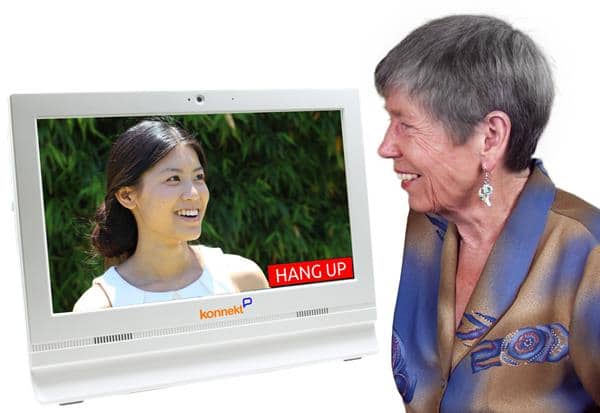Ten Tips to Optimise Video Call Quality
This guide helps you optimize video-call quality for Konnekt-supported video-calling platform and other in-market platforms such as Zoom, WhatsApp, FaceTime, Line, Microsoft Teams, Google Meet, Facebook Messenger, and WeChat.
Whether you’re connecting for work, catching up with friends, or keeping in touch with family, these tips will help you enjoy smoother, clearer video calls.
1. Use a Reliable Internet Connection
A wired connection is best. If you must use Wi-Fi, position yourself close to the router and minimise interference from other devices.
2. Close Unused Apps and Tabs
Shut down programs, browser tabs, or background apps that consume bandwidth and processing power.
3. Keep Your Device Updated
Ensure your operating system, web browser, and video-calling app are updated to the latest version for the best performance and security.
4. Choose the Right Device
Use a computer or tablet for better stability and larger screen size, unless you need the mobility of a smartphone.
5. Good Lighting and Camera Positioning
Face a window or use a lamp to light your face. Keep the camera at eye level for a natural conversation. You can order our recommended headphones.
6. Use Headphones or Earbuds
This helps reduce echo and improve sound clarity for both you and the other person.
7. Limit Other Network Use During Calls
Avoid streaming videos, large downloads, or online gaming on the same network while you’re on a call.
8. Try the Web Version if the App Misbehaves
Many platforms (Zoom, Google Meet, Teams, WhatsApp, Facebook Messenger) have web versions you can use through your browser, which can be handy if the app is glitchy.
9. Keep Your Software Light
Avoid “Lite” or low-bandwidth versions unless you are on a poor connection. While these may work on slow networks, they can reduce quality unnecessarily on faster connections.
10. Test Before Important Calls
Make a short test call to check your video and audio quality in advance.
Share the tips with your friends and family!
Konnekt Videophone provides a high-quality experience right out of the box.
Video calling apps can be too challenging for many people over 80, and for those with accessibility needs.
Konnekt’s friendly team helps the Videophone user, along with their family and friends, get set up on our supported video-calling app and enjoy the best possible call quality, no matter where they are.
Simply contact Konnekt to help your elderly parent, or someone you care about, connect face-to-face with the whole family — with high-quality picture and sound.
In our experience, insufficient Wi-Fi signal strength and slow Internet uplink speeds account for most video call quality issues. Relocating or upgrading an old Wi-Fi router can make a huge difference.
The TP-Link TL-MR6400 Wireless 4G LTE router can connect to the mobile Internet with high uplink speeds. It can also use your home fixed Internet connection if high availability is needed. After extended power outages (24 hours or more), it restarts automatically — unlike most battery-powered “pocket hotspot” portable 3G or 4G modems.
Optimise Wi-Fi and Internet
Ensure your Wi-Fi signal is 80% or better. Four out of five times, poor call quality is due to weak Wi-Fi. What feels like “good” Wi-Fi is often not enough for high-quality video calling. Browsing, social media, music, and even one-way video cope with poor Wi-Fi because they buffer — video calls cannot. For lip-reading quality, aim for 90–100%. This usually means being in the same room or in clear view of your Wi-Fi router.
Improve your signal:
- Open doors between you and the router
- Lift the router off the floor, out of cupboards, and away from clutter
- Check signal bars or rings on your device
- Replace routers over 5 years old or those needing frequent restarts
Choose the right band:
- 2.4 GHz is best for range and going through walls. Use this if you can’t be in the same room.
- 5 GHz is faster and works well in the same room or nearby.
- Give each band a different network name so you can select the best one for each device.
Extending coverage:
- Access point via Ethernet (best option)
- Powerline/MOCA extender using existing wiring
- Wi-Fi extender (easy to set up, but lower performance)
Wired connection: For a desktop or laptop in one location, use Ethernet for the most stable connection.
Increase Upload Speed
Good calls need:
- 0.7 Mbps each way for reasonable quality
- 1.5 Mbps for lip-reading clarity
- 2 Mbps+ for group calls
Ask your provider about upgrades such as Annex M for ADSL or a Speed Boost for cable/HFC.
Mobile Internet
When using mobile data:
- Aim for 3–4 bars or more
- Move near a window or closer to the tower
- Newer devices perform better on more frequency bands
- Portable 4G modems can improve tablet or older phone connections
Reduce Other Usage
- Ask others to pause streaming, gaming, and large uploads during calls
- Close unused apps on your device to free bandwidth and processing power
Optimise Audio Quality
Use a Headset
Wearing a headset, headphones, or earphones is the single most effective way to improve sound quality—for you and your contact. Even if only one person uses them, clarity improves significantly.
If wearing them isn’t practical, read the section on lowering your volume.
Reduce Noise and Wind
Background noise makes it harder for your contact to understand you and may cause them to turn up their speaker volume—creating more problems.
- Outdoors: Wind can distort your voice without you noticing. Move to shelter or cup your hand around the microphone to block wind.
- Indoors: Turn off TVs, pause music, and avoid noisy appliances.
If noise is unavoidable, wear a headset or move closer to your microphone.
Keep Mic and Speaker Close
Ideally, your mouth should be near the microphone and your ears close to the speaker. Without a headset, your device uses speakerphone mode, which is convenient but prone to echo—especially if both people use it and one increases the volume.
Understand “Loop Gain”
If you notice volume fluctuations on the first syllable, squealing, or difficulty interrupting each other, you may have too much loop gain—where sound travels in a feedback loop between speakers and microphones.
Even one person using a headset greatly reduces this problem, improving echo cancellation and making conversations more natural.
Lower Volumes
Counter-intuitively, lower speaker volume often improves clarity—especially if not using headphones. Also reduce microphone sensitivity to the lowest comfortable level.
Remove Covers
Hard covers (plastic or metal) can worsen sound by vibrating or channelling speaker audio to the mic. Removing the cover can noticeably improve quality.
Don’t Block the Mic or Speaker
Avoid covering them with your hand, finger, or a phone stand. Some stands grip the sides and leave space for buttons and sound—choose one suited to your device.
Avoid Echoey Rooms
Small, hard-surfaced rooms (e.g., bathrooms) cause reflections. Larger rooms with carpets, soft furniture, and wall hangings are better.
If using Wi-Fi, stay in the same room as your router.
Enable Audio Features
If you have one-way sound, very low volume, or no sound at all, check:
- Speaker mode: Toggle between speakerphone and regular phone mode.
- Mic mute: Ensure the microphone isn’t muted.
- Speaker mute/volume: Adjust side buttons or in-device settings.
On computers, check keyboard volume keys or system sound settings.
The best way to improve audio quality is to use a headset or earphones with a built-in microphone. This brings the mic close to your mouth and the speaker close to your ear.
The Jabra Evolve 65 is wireless for tangle-free, multi-tasking calls, cushioned for comfort with passive noise reduction, and can connect to both computer and mobile. The Mono version lets you stay alert for interruptions.
If you need headphones with frequency compensation, noise cancellation or fit over hearing aids, order our recommended headphones.
Dedicated Device for Video-calling – Videophone!
A dedicated device for video-calling completely avoids the complexity of video call apps and video calling. No keyboard, mouse or swiping. No logins, passwords or numbers. No menus, hard-to-remember icons or fiddly charging pads. Just BIG text and HUGE buttons on a LARGE screen, with LOUD sound. It’s ideal for older adults who may struggle to use something as complicated as an iPad, tablet, or even a regular telephone.
- Reduce social isolation: Frequent face-to-face contact can decrease social isolation and loneliness, lower the risk of depression, help prevent or treat dementia, and mitigate both physical and mental health risks.
- Regain independence: Being able to initiate and answer video calls provides an incredible confidence boost.
- See distant family: Seniors who cannot travel as frequently can use our video-calling app to maintain contact with remote relatives. Share a smile!
Make the first call delightful. Quality of Experience is all important for that first face-to-face call! In our experience, some older adults, particularly those with dementia, can be resistant to new technology. The quality and simplicity of that first call is vital. So many times, we have seen “nephew Bill” try to set up an iPad for “Gran”, only to see it end up as a TDF (Top Drawer Filler). Ease-of-use is everything. Be sure to complete all of your testing before you introduce our video-calling app to your elderly parent or grandparent. A dedicated video phone makes video calling incredibly simple so that you don’t have to worry about fear of technology.
Reduce your bills. A dedicated video phone can help you save:
- Travel: Video calls or group video conferences can supplement frequent in-person visits, cutting travel costs for the whole family.
- Phone bills: Using video and audio calling can eliminate or reduce the need for regular telephone calls, in both directions, for the whole family.
- Health: Social isolation, as a health risk, is worse than either cigarette smoking, inactivity or obesity. Poor health has a huge cost on society and on your wallet.
Learn about Konnekt’s dedicated video phone.
Need Help? Contact Konnekt for assistance with call quality.
Note that this guide contains tips useful for any video calling platform, and is subject to change.








